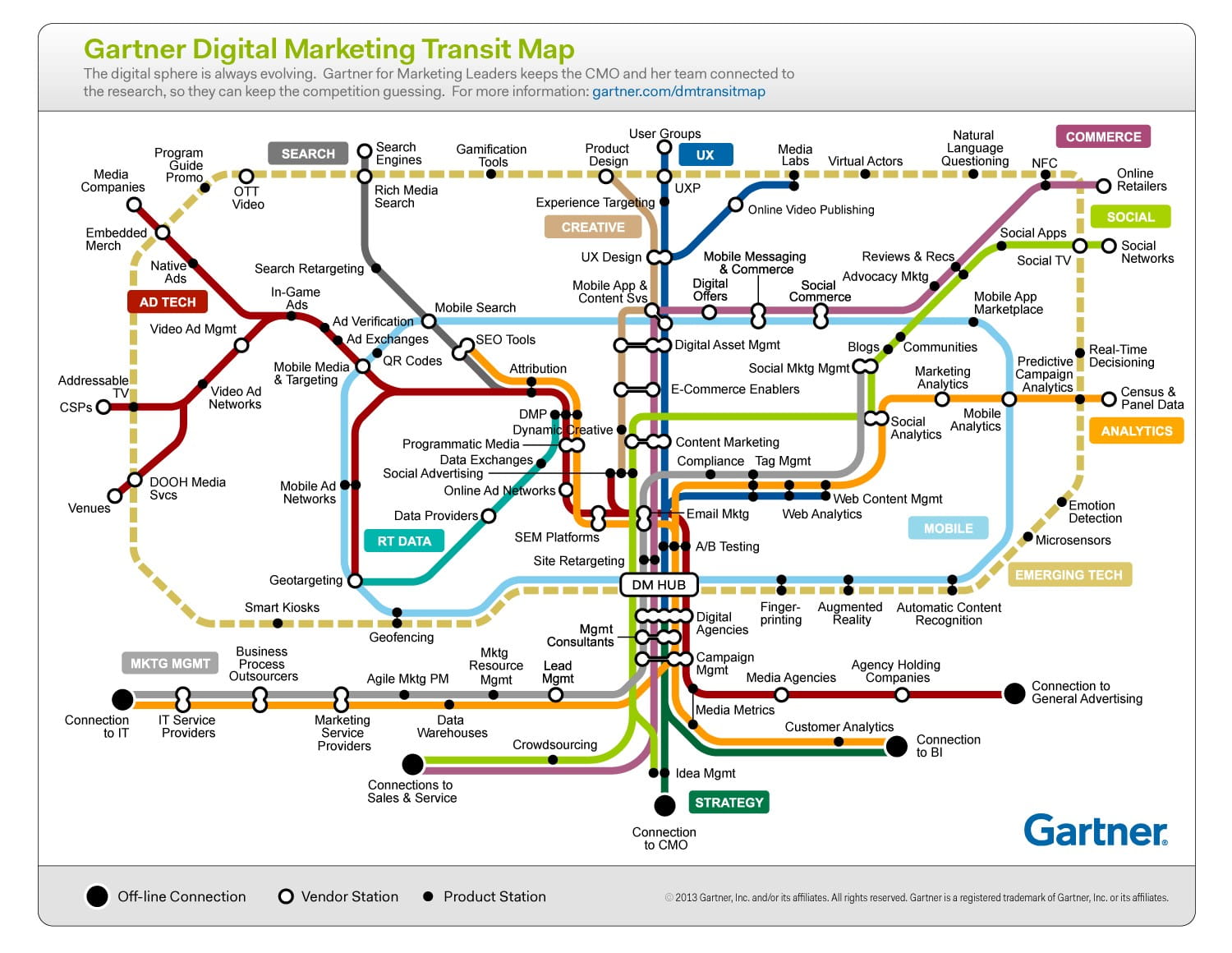
Sep. 28, 2016 | InBrief
Navigating the MarTech jungle in the credit card space
Navigating the MarTech jungle in the credit card space
This is the second post in a series of blogs looking at how credit card issuers have the opportunity to transform marketing to become truly personalized. In the first blog, we discussed the need for personalized marketing and the constraints that up until now made achieving it difficult. In this second blog, we explore the Marketing Technology (MarTech) landscape and provide guidance on the teams and capabilities you should consider when selecting MarTech solutions.
During a previous market assessment, we stumbled upon Gartner’s Transit Map. Gartner’s Transit Map displays the MarTech space, with each station representing an individual solution, organized into neighborhoods that represent a marketing capability.
WOAH.
At first glance, the map is extremely overwhelming. If you’re considering a MarTech investment, take a closer look. By organizing MarTech solutions (the stations) into neighborhoods (the color-coded rectangles), Gartner provides an overview on the various marketing capabilities and how they fit together. With the right combination of MarTech solutions, organizations can continue executing their typical credit card marketing campaigns to push messages to large customer segments, while also launching trigger-based campaigns that send messages to customers in segments of one:
But where do you start?
Before you get lost in the MarTech jungle, think about your organization’s capabilities to distinguish you from the competition. Think about your organization’s long-term marketing strategy and the capabilities you need to achieve your goal. Which capabilities need to be enhanced in order for you to remain competitive? Which capabilities are missing from your organization and preventing you from achieving your marketing strategy?
Next, sit down with teams in other business functions within your organization to see where your needs align. We recommend marketing include advertising, customer service (or any team focused on the customer experience), and IT teams in MarTech discussions because:
- Marketing must know which advertising communication a newly acquired customer responded to in order to predict which campaigns will be relevant to the customer moving forward.
- Customer service representatives must understand the scope of marketing’s campaigns to effectively respond to customer inquiries, such as complaints about awards customers were promised in an email but have yet to see on their accounts.
- IT must work with marketing to ensure the organization’s data architecture provides the necessary support for purchased MarTech solutions. IT will help make sense of the data storage and analysis requirements, enabling the personalized communications marketing envisions.
Cross-functional collaboration helps organizations maximize the benefits MarTech solutions can have on top-line revenue. Collaboration makes business functions aware of one another’s touch points with customers, making internal hand-offs imperceptible in the customer journey. The organization will avoid redundancy and contradictions in their communications with customers. A positive customer experience will attract more customers and increase loyalty, meaning greater ROI on MarTech solutions.
What capabilities enable personalized messaging?
- Dynamic content management: Dynamic content management tools help you respond to customers at a greater speed and with greater consistency. These tools provide a central location to store, edit, and version your campaign content in small components to ensure:
- Your campaign content is stored in small components, making it easy to re-use and re-combine components of various campaigns to create new messages for customers. This strategy helps keep messages consistent across all channels and avoids customer confusion.
- All components of your campaign’s content are stored and edited in a centralized location so updates are reflected across all channels, ensuring consistent branding, offers and rewards in your messages to customers.
- Journey mapping: Journey maps visualize the context in which a customer will receive a marketing message. As previously discussed, this allows you to coordinate with other teams in your organization who engage with customers, ensuring consistency in communications with customers across business functions. Journey maps also provide insight into a customer’s lifestyle beyond the touch points with your organization, showing you when a customer will be most likely to respond to an offer, and the channel a customer prefers to receive the offer.
- Predictive analytics: Predictive analytics enable you to determine which customers are most likely to respond to your various marketing campaigns. Analyzing third-party data in addition to your own will allow you to make more informed predictions.
Dynamic content management, journey mapping, and predictive analytics are only three capabilities among many that are needed to launch successful marketing campaigns. We highlight these three capabilities because they are the capabilities most organizations have yet to invest in adequately. These capabilities enable organizations to respond to customers and market trends with greater speed and relevancy. They will help your organization launch campaigns that target segments of one to complement your campaigns that target larger segments.
To successfully implement these MarTech capabilities, your organization must employ data architecture to centralize customer data from all business functions across an organization. Our next blog will explore how to build data architecture to support real-time monitoring of customer touchpoints, identifying patterns across those touchpoints, and responding to customer behaviors based on those patterns.
